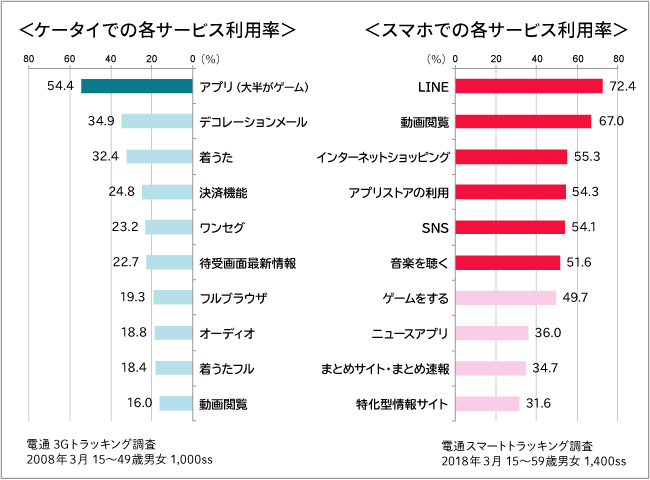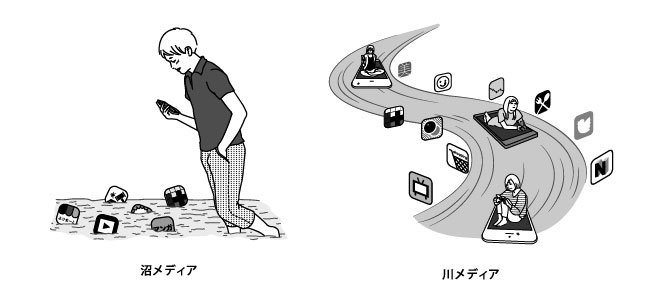As the title "Smartphones Are Not Just Devices, They Are Environments" suggests, looking at the relationship between smartphones and consumers over recent years, I believe smartphones have transcended being mere devices and can be seen as a type of environment. They are taken for granted, and life without them is unimaginable.
If something catches our attention, we take a photo with our smartphone; information we care about appears in our field of vision with a touch. Many daily actions have shifted to being smartphone-dependent. My book, Smartphone Marketing, summarizes these changes and realities alongside consumer insights.

The book is now available! Details
here.
In this series, we'll explore consumer psychology through surveys on mobile device usage and newly emerging digital devices, and consider the post-smartphone era.
What impact has the constant presence of smartphones had?
Mobile device usage functions differ significantly between 2008, the peak of feature phone maturity, and 2018.
Changes in Mobile Device Usage Functions [2008 → 2018]

During the feature phone era, video viewing faced numerous restrictions. Even at the peak of their evolution, less than 20% of users watched videos.
However, today nearly 70% of smartphone users watch videos, meaning most smartphone owners view videos on their devices. Stills have circulated since the feature phone era, and with the mainstreaming of video, both communication and information transmission have shifted to a visually-centric environment.
Given the vast amount of information now accessible, consumers seek efficient ways to gather information. For complex topics requiring understanding, passively watching a video is often easier and provides a stronger sense of comprehension than reading text. In a sense, video has become the "most efficient means of information comprehension" at this point.
While social networking services (SNS) and internet shopping saw minimal adoption on feature phones, smartphone usage rates for both exceed 50%, clearly demonstrating these are domains that blossomed with smartphones.
SNS not only connects users with real-life friends but also facilitates the creation of niche networks based on interests like hobbies. Each time users access these platforms, information of interest catches their eye.
Online shopping provides an environment where you can shop anywhere, and content like music, manga, and anime has become universally accessible regardless of location.
The widespread adoption of smartphones as devices and their integration into daily life has built this environment where people can do what they want, wherever they want. Consumers naturally started watching videos, shopping online, and enjoying various types of content.
"Marsh Media" and "River Media": Where You "Just Can't Help" Getting Drawn In
Smartphones, capable of anything, have become tools that people inevitably use, guiding them along.
Smartphones possess two distinct aspects: the "Swamp Media" side, where users easily try out free content that catches their interest and "end up" getting hooked. Additionally, the "River Media" side, where users, despite having a specific product in mind, quickly forget their original purpose and "end up" being carried away to different product pages (online shopping sites).

In fact, consumers view effortlessly getting hooked or swept along positively. Because it's easy to enjoy, find what they want, and buy it.
For example, reviews and social media make it visible who is enjoying content that catches your interest. You often find yourself thinking "This looks interesting" before you know it. Furthermore, much content offers a free trial experience, with monetization waiting when you want to enjoy more.
Of course, it can sometimes lead to wasted time. However, considering the effort required to find the best content for oneself and the risk of paying for something that might not be interesting, the "sinkhole media" structure offers an overwhelmingly efficient environment.
With "River Media," too, rather than spending time deciding what to buy, you can more easily get the satisfying feeling of having bought something reliable by simply going with the flow of information: things with generally good reviews, high rankings, or positive buzz on social media.
Most people can't escape the pull of ease and convenience; they naturally adapt to their environment. Especially when it comes to convenient environments, they increasingly tailor them to suit their own preferences.
The more you use your smartphone, the more it tailors itself to your interests and preferences, creating an increasingly comfortable environment. Information about your hobbies, which you once had to actively seek out, becomes smoothly accessible within your routine smartphone usage.
The maturation of the smartphone market is also maturing the relationship between people and their smartphones. While the smartphone environment now allows effortless enjoyment in ways unimaginable a decade ago, this environment has already become commonplace for users.
And even easier, more convenient things are emerging in the world. By catching these signs, we can gradually glimpse the easy, convenient life of five or ten years from now.
Next time, we'll explore the world "beyond" smartphones by examining the actual usage patterns of AI speakers, which are creating even more convenient environments.





